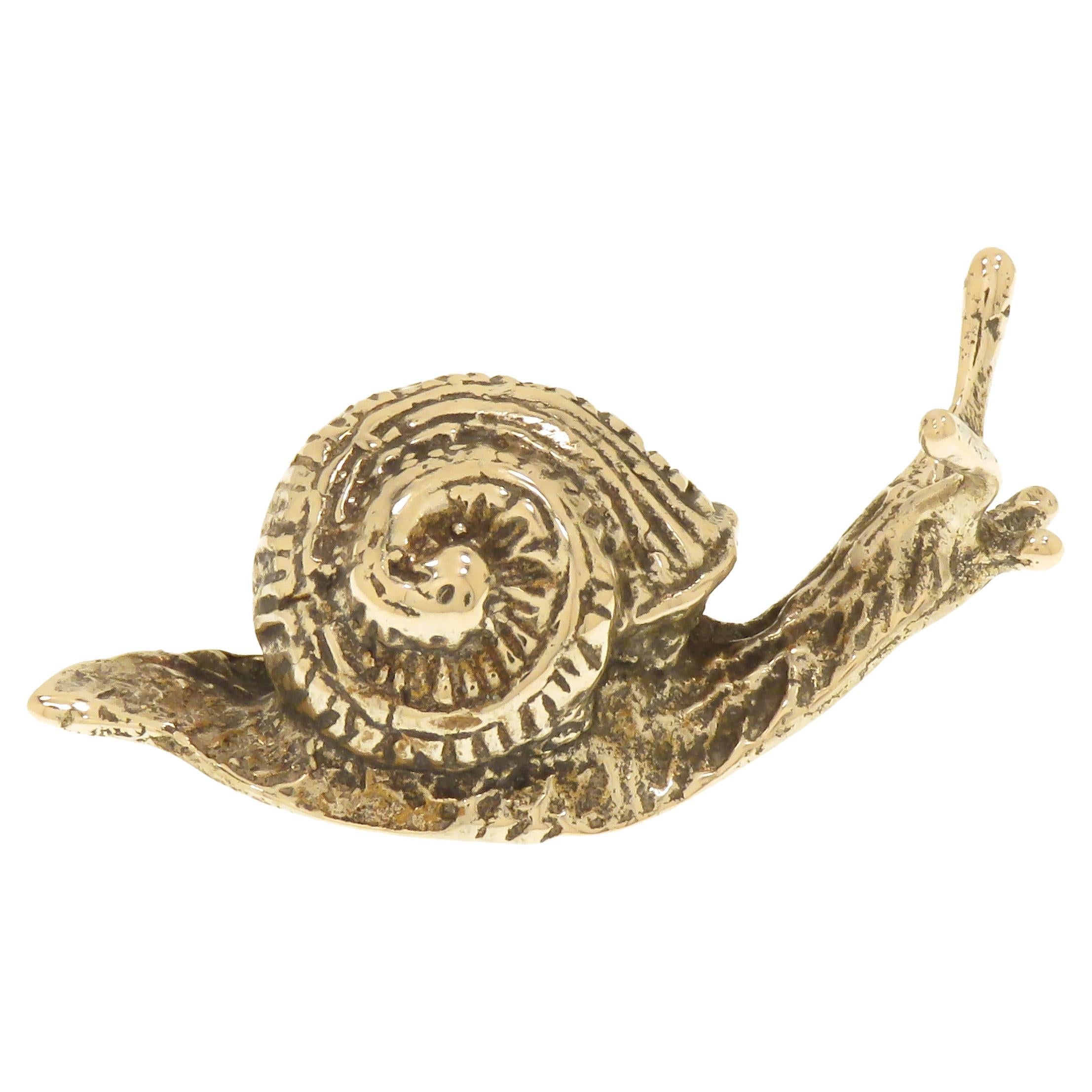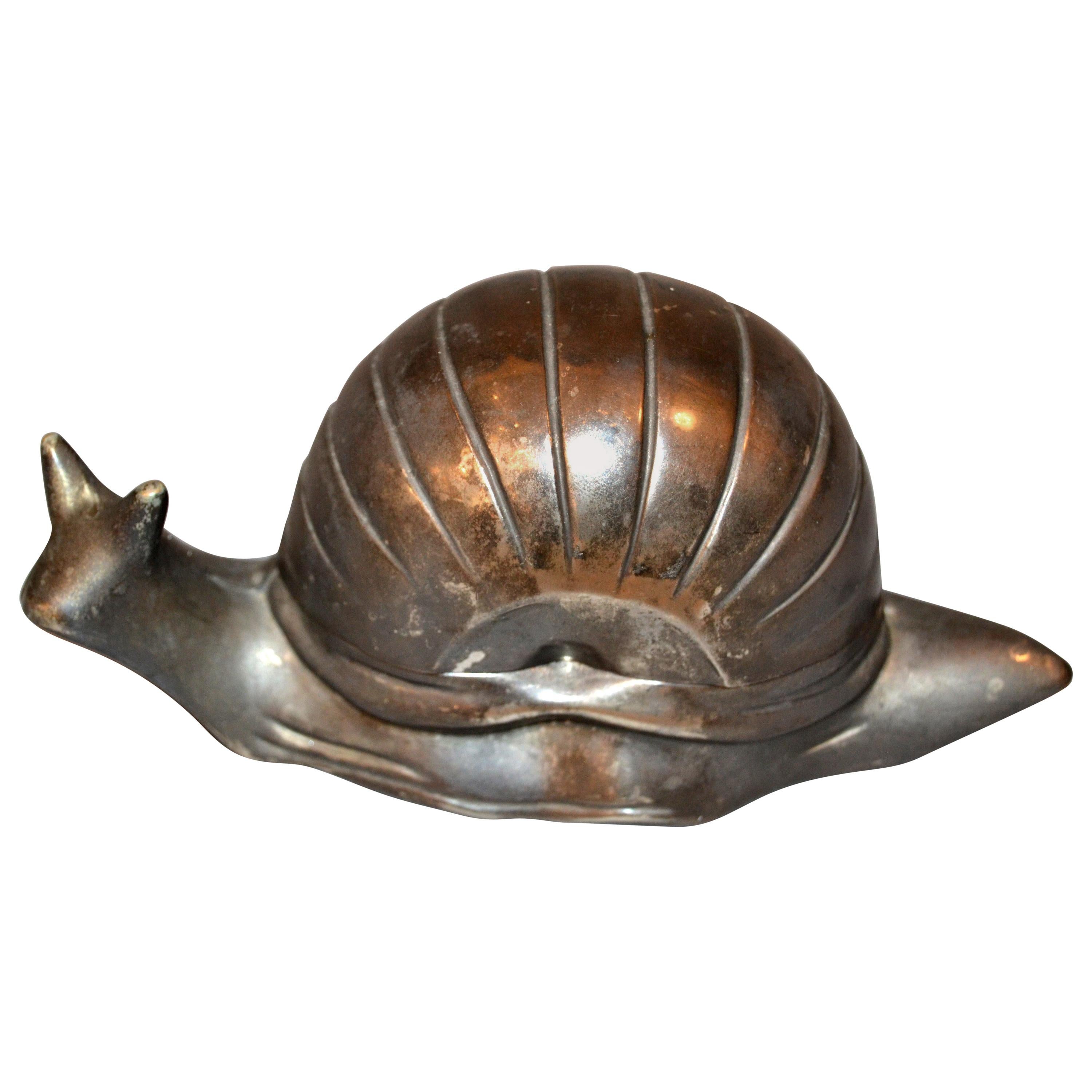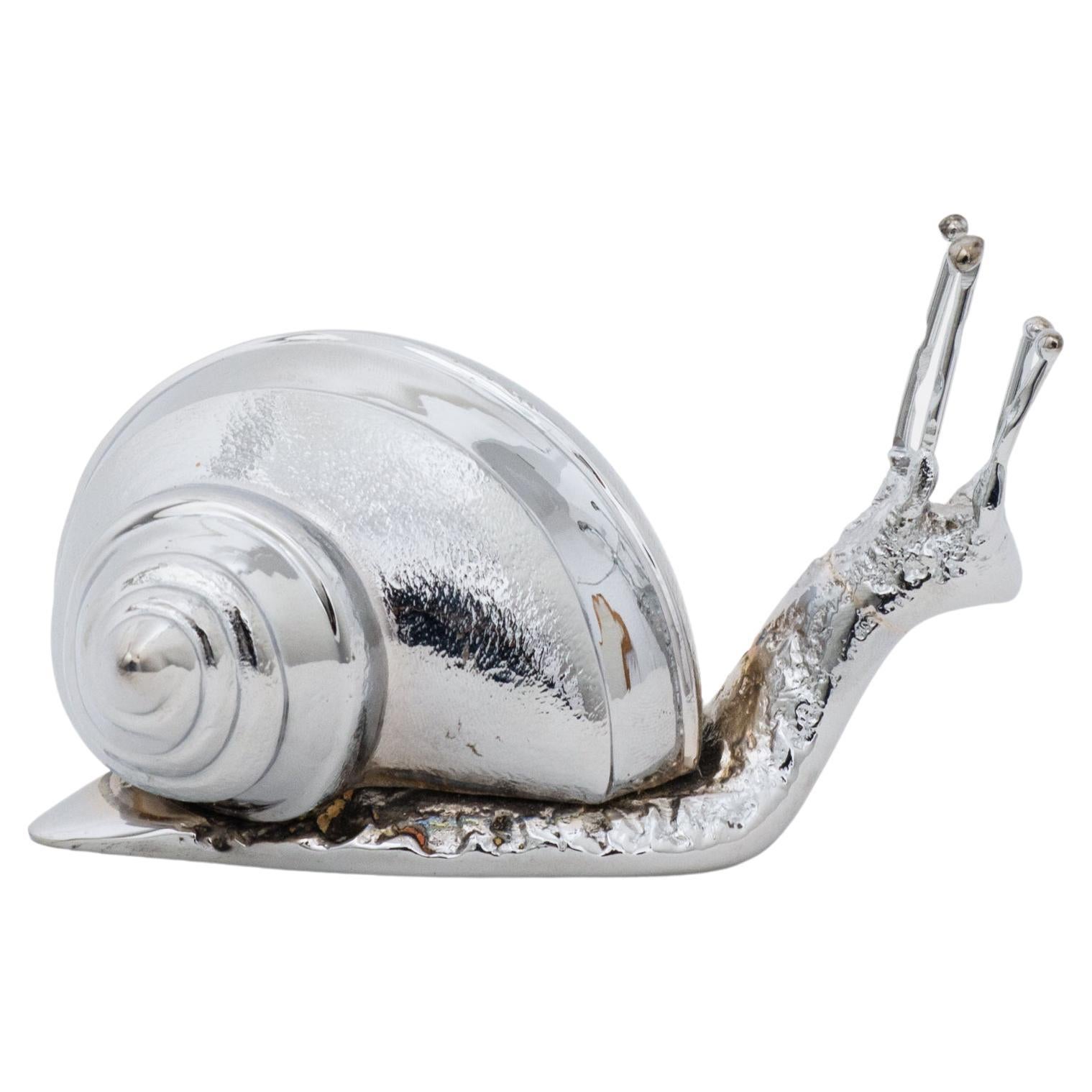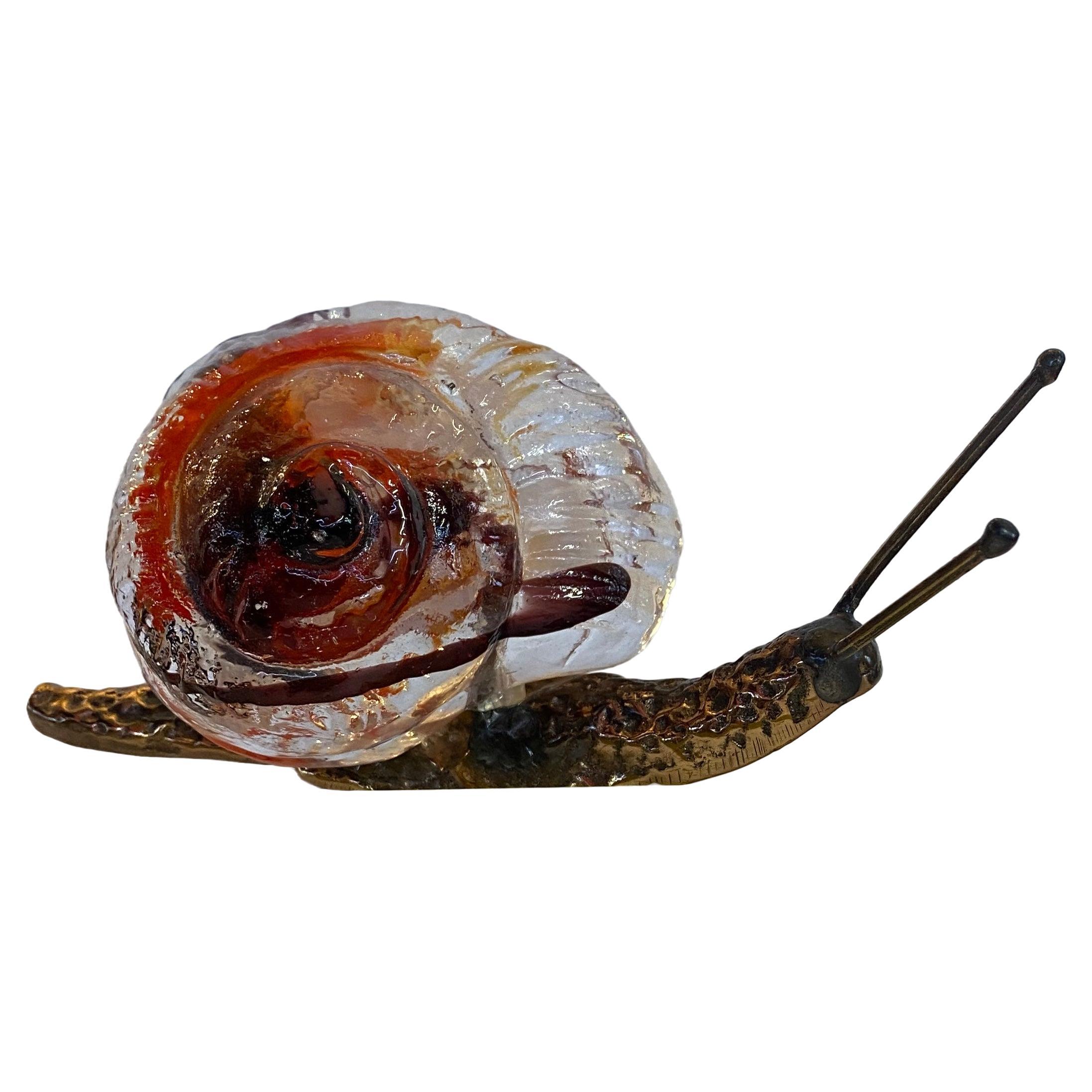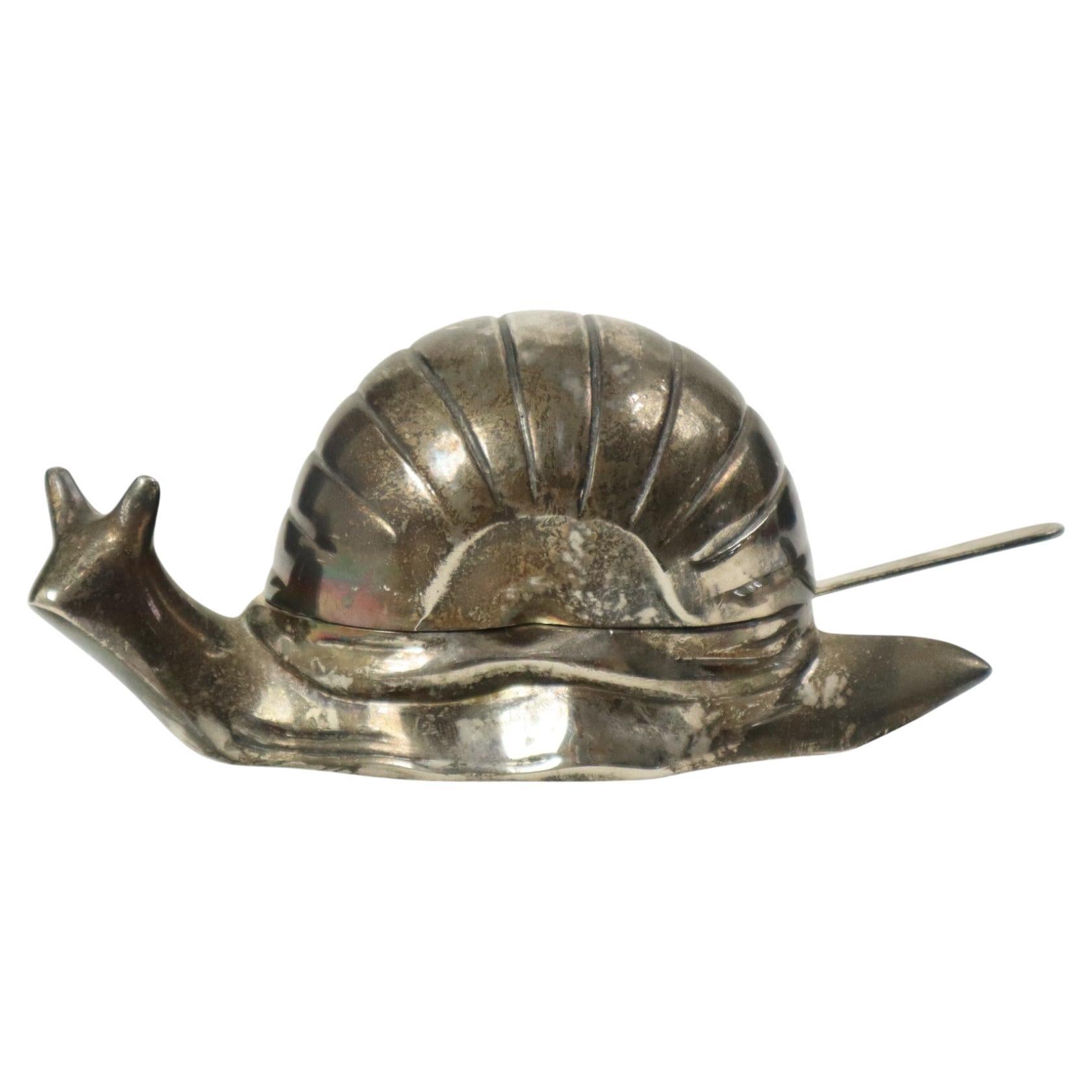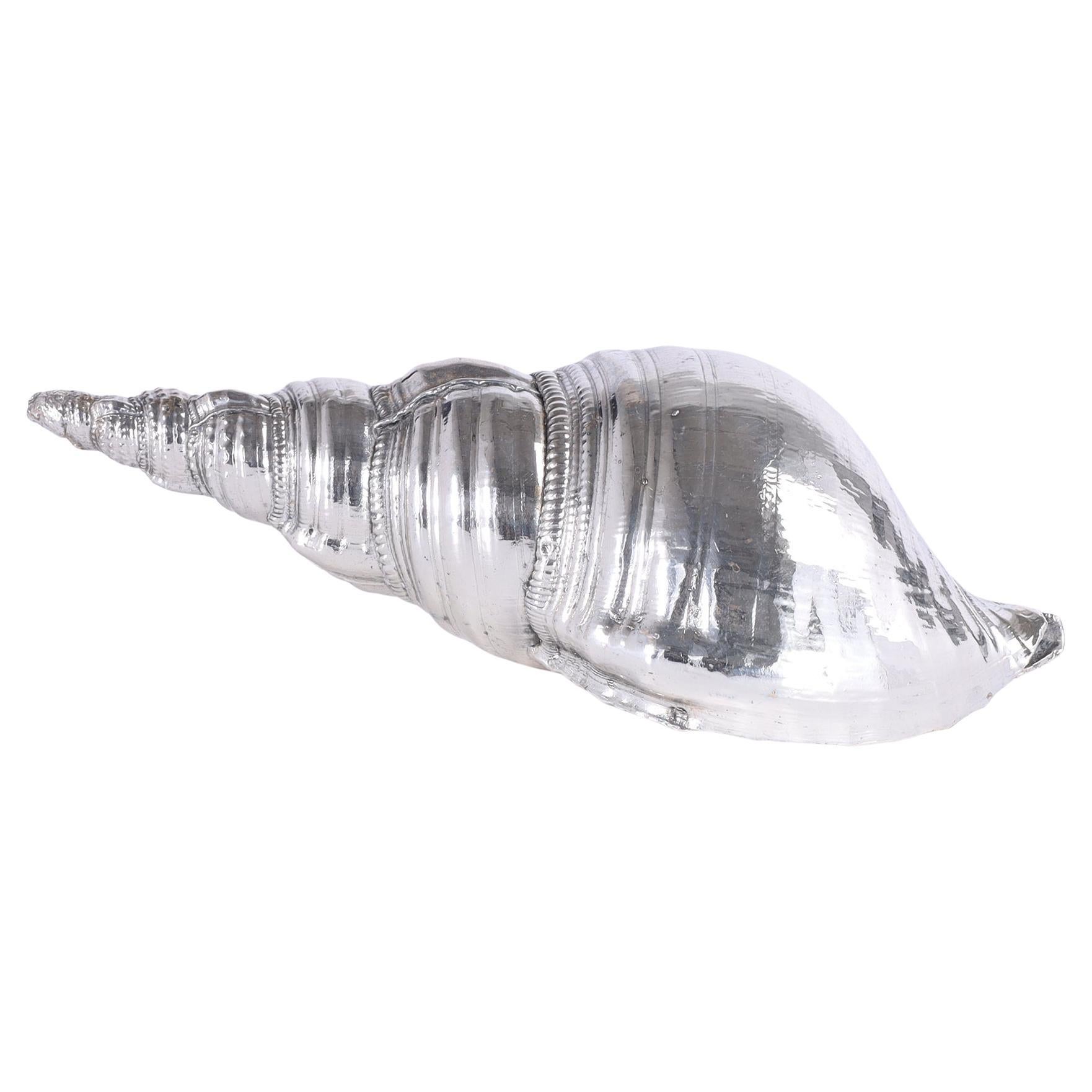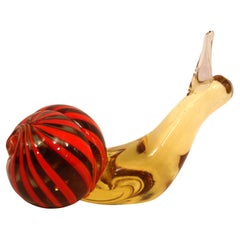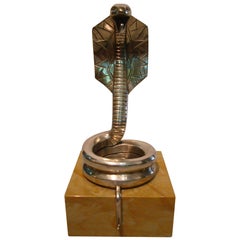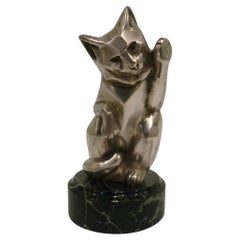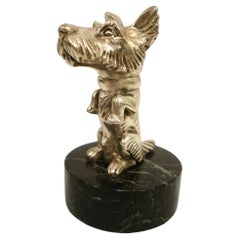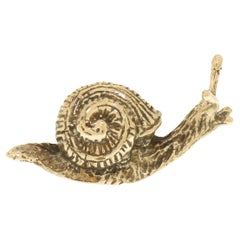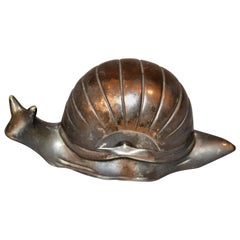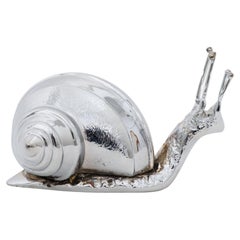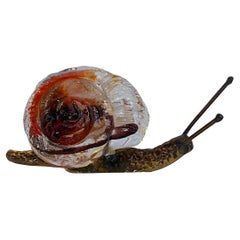Items Similar to Sterling Silver and Shell Snail Sculpture Paperweight
Want more images or videos?
Request additional images or videos from the seller
1 of 11
Sterling Silver and Shell Snail Sculpture Paperweight
$1,400
£1,038.85
€1,210.12
CA$1,948.81
A$2,170.18
CHF 1,129.46
MX$26,758.01
NOK 14,384.49
SEK 13,520.03
DKK 9,029.02
Shipping
Retrieving quote...The 1stDibs Promise:
Authenticity Guarantee,
Money-Back Guarantee,
24-Hour Cancellation
About the Item
Wonderful Snail made from Sterling Silver that shows the hand of the craftsman who created it. To complete the illusion the snail has the addition of a real sea shell. Very nice sculpture, can be used as paperweight.
We have specialized in the sale of Art Deco and Art Nouveau and Vintage styles since 1995. If you have any questions we are at your disposal. Pushing the button that reads 'View All From Seller'. And you can see more objects to the style for sale. Why are there so many antiques in Argentina?
In the 1880 – 1940 there was a grate wave of immigration encouraged by the periods of war that were taking place. 1st World War took place between 1914 and 1918 2nd World War took place between 1939 and 1945 The immigrants options were New York or Buenos Aires. Tickets were cheap and in Buenos Aires they were welcomed with open arms, as it was a country where everything was still to be done. Argentina was the country of new opportunities, labour was needed and religious freedom was assured, in many cases the of the family travel first until they were settled and then the rest of the family members join them. In the immigrant museum “Ellis Island Immigrant Building” in New York you can se the promotional posters of the boats that would take them to a new life. Between the years 1895 and 1896, Argentina had the highest DGP (gross domestic product) per capita in the world according to the Maddison Historical Statistics index, this situation arose due to the large amount of food being exported to European countries, which were at war. The Argentinean ships left the port of Buenos Aires with food, but they returned with furniture, clothes and construction elements, (it´s common to see this the old buildings of the historic neighbourhood of San Telmo, the beams with the inscription “Made in England)”, as well as many markets that were built in Buenos Aires, such us the San Telmo Market, whose structure was brought by ship and afterwards assembled in 900 Defensa Street. With the great influence of European immigrants living in the country, the children of the upper classes travelled to study in France, resulting in the inauguration of “La Maison Argentinienne”, on 27th of June 1928, in the international city of Paris, which hosted many Argentinians that were studying in Frace. It´s the fourth house to be built after France, Canada and Belgium, being the first Spanish-speaking one. Still in place today (17 Bd Jourdan, 75014, Paris, France). Many of the children of these wealthy families who attended international art exhibitions, museums and art courses abroad, took a keen interest in the European style. This is why Buenos Aires was at the time referred as “The Paris of South America”. Between the years 1890 and 1920 more than a hundred Palaces were built on Alvear Avenue the most exclusive avenue in Buenos Aires. Today some of these palaces have been transformed into museums, hotels and embassies. In the year 1936, the Kavanagh building was inaugurated, it was the tallest reinforced concrete building in South America. During 1994 the American Society of Civil Engineers distinguished it as an “international engineering milestone”, and it´s now considered a World Heritage of Modern Architecture. At the time was common to hire foreign architects such as Le Corbusier, who visited Buenos Aires/Argentina in 1929 and in 1948 he drew up the blueprints for a house built in La Plata City (which was declared a World Heritage Site). In 1947, the Hungarian architect Marcelo Breuer designed “Parador Ariston” in the seaside city of Mar del Plata. After an Argentinean student at Harvard University convinced him to come to Argentina. He worked on an urban development project in the Casa Amarilla, area of La Boca. The Ukrainian architect, Vladimiro Acosta, arrives in Argentina in 1928 and worked as an architect until que moved to Brazil. Antonio Bonet, a Spanish architect who worked with Le Corbusier in Paris, arrives in Argentina in 1937, where he carried out several architectural works and in 1938 designs the well-known BFK chair. Andres Kálnay, of Hungarian origin, made around 120 architectural masterpieces, among which the former Munich brewery stands out, he even made the furniture’s design. The German architect, Walter Gropius, director of the Bauhaus, lived in Argentina, where he wrote articles for “Sur” magazine and founded in Buenos Aires, an architectural firm with Franz Möller, who was also an architect, where he built two houses. At the same time several famous designers decided to immigrate to Argentina, among them we can find the well-known French designer, Jean-Michel Frank, who arrived in the country in 1940 and also worked for the Rockefeller family. Special pieces were made, which were sold exclusively in the country, such as the well-known German company “WMF”, who sold their products by catalogue, which were chosen by the ladies of high society in the list of wedding gifts, as well as the pieces designed by Christofle. The Swiss sculptor Alberto Giacometti, made special pieces for Argentinean mansions. In 1904 the first Jansen branch outside Paris was established in Buenos Aires, as the Argentinean clientele demanded a large amount of furniture, from the end of the 19th century to the mid-20th century. In 1970, the brand Rigolleau Argentina made pieces authorised by Lalique. The brands Maple and Thompson also set up shop in the country. The French plastic artist, Marcel Duchamp moved to Argentina in 1918-1919. Glass signed Gallé, Charder, Leverre, Schneider, Muller and other French firms. They were bought in flower shops and were given to ladies with beautiful floral arrangements. Some furniture manufacturers travelled to international fairs and bough the patterns to produce the furniture in Argentina, such as the furniture firm Englander and Bonta, who bought the patterns in Italy. It is worth mentioning that in Argentina we have the largest community of Italians outside of Italy, as it is estimated that 70 percent of the inhabitants have at least one Italian descendant, followed by Spanish immigrants. The most Important furniture stores in Argentina: Comte is founded in 1934 (under the direct management of Jean Michel Frank in 1940). Nordiska (Swedish company established in 1934). Churba in 1960, a company that brought foreign designers to present their furniture in the country: Denmark: (Arne Jacobsen, Finn Juhl, Bender Madsen, Ejner Larsen, Poul Kjaerholm, Hans Wegner) Sweden: (Hans Agne Jakobsson, Gustavsberg) United States: (Herman Miller) Finland: (Lisa Johansson, Folke Arstrom, Tapio Wirkkala, Alvar Aalto, Timo Sarpaneva) Swedish Factory: (Orrefors) Italy: (Littala, Vico Magistretti, Emma Gismondi, Gae Aulenti, Angelo Mangiarotti, Elio Martinelli, Gianna Celada, Angelo Mangiarotti, Mario Bellini, Carlo Scarpa) Finland: (Olivia Toikka) Plata Lappas (Lappas Silver): a goldsmith shop founded in 1887 in Argentina by Alcibiades Lappas of Greek origin. In 2019, in Argentina took place “the Art Deco world congress” . Argentina currently has more than 100 Art Deco buildings and another 90 Art Nouveau buildings throughout the city of Buenos Aires. Argentina is a country that has not been involved in many wars, which is why it has been a refuge for works of art and antiques from different periods of time, unlike European countries. That is way many collectors, museums and antique dealers from all over the world visit it, you should not miss the opportunity to visit this great country.
- Dimensions:Height: 2.37 in (6 cm)Width: 5.91 in (15 cm)Depth: 2.37 in (6 cm)
- Style:Mid-Century Modern (Of the Period)
- Materials and Techniques:
- Place of Origin:
- Period:
- Date of Manufacture:1960´s
- Condition:Wear consistent with age and use.
- Seller Location:Buenos Aires, AR
- Reference Number:1stDibs: LU2027337141842
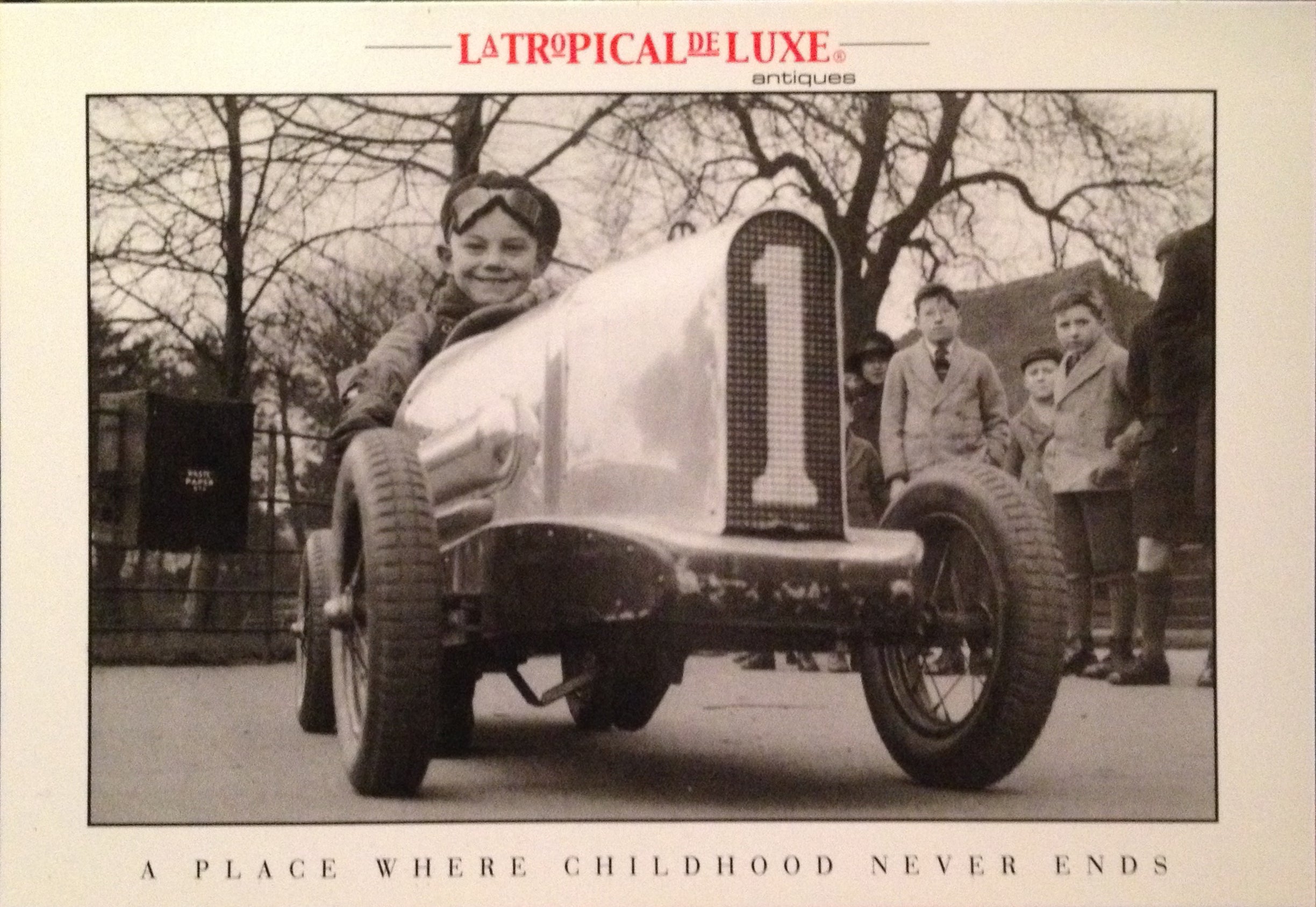
About the Seller
4.9
Vetted Professional Seller
Every seller passes strict standards for authenticity and reliability
Established in 2002
1stDibs seller since 2016
319 sales on 1stDibs
Typical response time: 1 hour
- ShippingRetrieving quote...Shipping from: Buenos Aires, Argentina
- Return Policy
Authenticity Guarantee
In the unlikely event there’s an issue with an item’s authenticity, contact us within 1 year for a full refund. DetailsMoney-Back Guarantee
If your item is not as described, is damaged in transit, or does not arrive, contact us within 7 days for a full refund. Details24-Hour Cancellation
You have a 24-hour grace period in which to reconsider your purchase, with no questions asked.Vetted Professional Sellers
Our world-class sellers must adhere to strict standards for service and quality, maintaining the integrity of our listings.Price-Match Guarantee
If you find that a seller listed the same item for a lower price elsewhere, we’ll match it.Trusted Global Delivery
Our best-in-class carrier network provides specialized shipping options worldwide, including custom delivery.More From This Seller
View AllMid Century Hand Blown Two-Tone Murando Art Glass Snail - Italy 1960´s
By Livio Seguso
Located in Buenos Aires, Olivos
Mid Century Hand Blown Two-Tone Murando Art Glass Snail - Italy 1960´s.
This charming stylized snail by Livio Seguso, exemplifies the finesse of the Venetian Glass masters skills in ...
Category
Mid-20th Century Italian Mid-Century Modern Figurative Sculptures
Materials
Murano Glass
Art Deco Silvered Bronze Cobra Snake Paperweight / Car Mascot by Rischmann
Located in Buenos Aires, Olivos
Art Deco silvered bronze cobra Snake Car Mascot / Hood Ornament / Paperweight or Watch stand by Rischmann, France, 1920s.
Silvered bronze sculpture of a cobra figure, mounted on a li...
Category
Vintage 1920s French Art Deco Animal Sculptures
Materials
Bronze
Art Deco Cat Sculpture Paperweight Silvered Bronze. Signed Rochard, France 1920
By Irénée Rochard
Located in Buenos Aires, Olivos
Art Deco Cat Sculpture / Figure Silvered Bronze. Signed Irénée Rochard. Made in France 1920´s. Lovely desk paperweight of a sitting cat playing,...
Category
Early 20th Century French Art Deco Animal Sculptures
Materials
Marble, Bronze
$1,200 Sale Price
20% Off
Vintage Terrier Silvered Sculpture / Desk Paperweight. c1930´s
Located in Buenos Aires, Olivos
Midcentury small silvered metallic sculpture of a dog, likely a terrier breed, standing on its hind legs with its front paws raised. The dog is detailed with fur texture and facial f...
Category
Mid-20th Century French Mid-Century Modern Animal Sculptures
Materials
Marble, Metal
Art Deco Elephant Paperweight. Retailed by Asprey - London 1930´s
By Asprey International Limited
Located in Buenos Aires, Olivos
Art Deco Pewter Elephant Paperweight. Retailed by Asprey - London 1930´s
Small statue of an elephant standing on its hind legs with its trunk raised. T...
Category
Mid-20th Century British Art Deco Animal Sculptures
Materials
Marble, Metal
Joseph Reinemann Jugendstil Pewter Novelty Bird Desk Inkwell, Germany c1902
By Robert Wallace Martin, Arts and Crafts Company, Martin Brothers
Located in Buenos Aires, Olivos
Joseph Reinemann Jugendstil Pewter Novelty Bird Desk Inkwell, Germany c1902.
Joseph Reinemann, Munich, a Jugendstil silvered pewter novelty desk inkwell in the form of a grotesque bi...
Category
Antique Early 1900s German Arts and Crafts Inkwells
Materials
Pewter
You May Also Like
Solid Silver Snail Figurine Vintage 1970s Made in Italy
Located in Milano, IT
Solid silver snail very good vintage condition.
Dimensions: Height 12 mm / 0.472 inches - Length 36 mm / 1.417 inches - Weight 9 grams.
It is stamped wit...
Category
Vintage 1970s Italian Retro Figurines and Sculptures
Materials
Silver
Vintage Silver Plate Snail Salt Dish Spice Dish with Glass Inlay
Located in Miami, FL
A vintage salt or spice dish designed as a snail with a glass tray inside.
Label silver plated on the bottom.
Makes the perfect timeless gift!
A-816-335
Category
Mid-20th Century American Mid-Century Modern Tableware
Materials
Silver Plate
$332 Sale Price
30% Off
Handmade Nickel Plated Decorative Snail, Paperweight
By Alguacil & Perkoff Ltd.
Located in London, GB
Each of these exquisite solid brass snails is handmade individually with incredible detail. Cast using very traditional techniques, they are finished with a nickel plating giving the...
Category
2010s Indian Organic Modern Animal Sculptures
Materials
Nickel
1970/80 Snail In Bronze And Glass Paste, Sculpture Signed LOHE
By Lohe
Located in Paris, FR
Sculpture in the shape of a snail in gilded bronze and glass paste signature LOHE Yves born in 1947, good condition, Circa 1970/80
Width: 19 cm
Length: 19 cm
Height: 8 cm
Category
Vintage 1970s French Brutalist Animal Sculptures
Materials
Bronze
Vintage Silver Plated Butter Dish Snail EP Zinc Hong Kong 1960s
Located in Poperinge, BE
Vintage silver plated butter dish in the shape of a snail, including glass insert and knife, marked EP zinc alloy Hong Kong on the inside, circa 1960s.
This vintage butter dish is c...
Category
Mid-20th Century Japanese Tableware
Materials
Silver Plate, Zinc
Vintage Italian Silver Plated Seashell by Mastro Argentiere
Located in Palm Beach, FL
Striking reborn seashell or conch silver plated to enhance the sculptural elements, signed Mastro Agentiere Italy on the inside.
Category
20th Century Italian Mid-Century Modern Natural Specimens
Materials
Silver Plate
More Ways To Browse
Art Nouveau Shell
Silver Sea Shells
Glass Snail
Italian Snail
19th Century Shell Chairs
Silver Snail
Sea Snail
Art Glass Snail
Art Deco Shell Chair
Hans Wegner Shell
Hans Wegner Shell Chair
Wegner Shell Chair
Herman Miller 1970 Shell Chair
Masterpiece International Sterling
Maison Jansen Shell
Christofle Shell
Christofle Marly Sterling
Spelter Antelope
